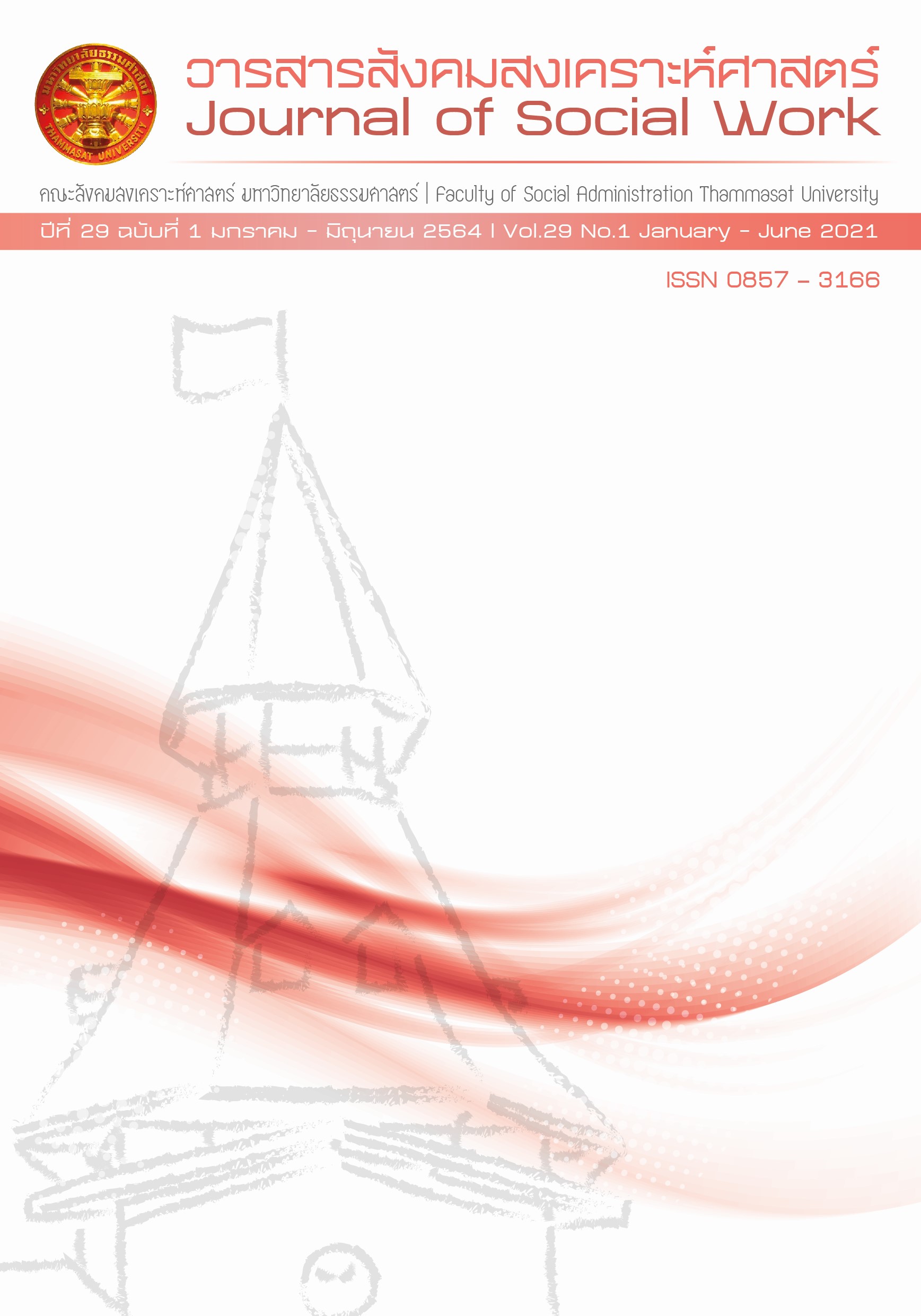Lessons Learned from Formative Evaluation: A Case Study of the Care Prevention Program in Japan
Keywords:
Formative evaluation, Care Prevention Program, Active agingAbstract
The objective of this research was to study The lessons learned from the formative evaluation of the Care Prevention Program in Japan. The sample was 8 staff members from two municipalities (Tokyo and Kanagawa Prefectures) in urban areas in Japan. All participants were representatives at the policy and practitioner level of the program. An interview with questions concerning program policy was used as a research instrument. The qualitative data were analyzed using thematic content analysis. The study revealed that this program was implemented through five steps 1) conducting a survey 2) network mobilization 3) activity planning 4) promoting the program and 5) evaluation. The strength of the program was the variety of the activities in various dimensions: physical, psychological and social. Most of the activities were designed to match with the characteristics of the older adults to encourage them to be active. A weakness of the program was in a lack of public places to organize the activities, as well as The high cost of renting venues for activities. However, factors that make the program effective include selecting community appropriate venues, creating a mechanism for public civil society and providing an operation manual. In summary, it can be concluded that, apart from health activities, other activities within the multi-dimensional range could help improve the program. In addition, understanding the situation and the context of each community could strengthen the program and aid in selecting appropriate venues for organizing activities.
References
Alwin, D. F. (2011). Demographic transitions and life-span development. In K. L. Fingerman, C. A. Berg, J. Smith, & T. C. Antonucci (Eds.), Handbook of life-span development (pp. 673–699). Springer Publishing Company.
Burnard, P., Gill, P., Stewart, K., Treasure, E., & Chadwick, B. (2008). Analysing and presenting qualitative data. British Dental Journal, 204(8), 429-432. https://doi.org/10.1038/sj.bdj.2008.292
Caprara, M., Molina, M.A., Schettini, R., Santacreu, M., Orosa, T., Mendoza-Nunez, V. M., Rojas, M., & Fernandez-Ballesteros, R. (2013). Active Aging Promotion: Results from the vital aging program. Current Gerontology and Geriatrics Research. Vol. 2013, 1-14. https//dx.doi.org/10.1155/2013/817813
Curry, N., Clarke, C. S., & Hemmings, N. (2018). What can England learn from the long-term care system in Japan?. London: Nuffield Trust.
Fertman, C.I., & Allensworth, D.D. (2010). Health Promotion Programs: From Theory to Practice. Jossey-Bass, A. Wiley Imprint.
Health and Welfare Bureau for the Elderly, Ministry of Health, Labour and Welfare of Japan. (2017). Manual for Community Care Prevention Program.
Kalache, A., & Kickbusch, I. (1997). A global strategy for healthy ageing. World Health, 50(4), 4 – 5. https://apps.who.int/iris/handle/10665/330616
Knodel, J.,Teerawichitchainan, B. P., Prachuabmoh,V., & Pothisri, W. (2015). The situation of Thailand’s older population: An update based on the 2014 survey of older persons in Thailand. Research Collection School of Social Sciences.
Manual for Community Care Prevention Program. (2017) Ministry of Health, Labor and Welfare of Japan Mendoza-Ruvalcaba, M. N., & Arias-Merino, D. E. (2015). “I am active”: Effects of a program to promote active aging. Clinical Interventions in Aging, 10, 829-837. https://DOI: 10.2147/CIA.S79511
Ministry of Health, Labour and Welfare of Japan. (2014). Annual Health, Labour and Welfare Report. http://www.mhlw.go.jp/english/wp/
Ministry of Health, Labour and Welfare of Japan. (2016). Annual Health, Labour and Welfare Report. http://www.mhlw.go.jp/english/wp/
Ministry of Health, Labour and Welfare of Japan. (2017). Annual Health, Labour and Welfare Report. http://www.mhlw.go.jp/english/wp/
O' Connor, H., & Gibson, N. (2003). A Step-by-Step Guide to Qualitative Data Analysis. Pimatisiwin: A Journal of Aboriginal and Indigenous Community Health, 1, 63-90.
Odendaal, W., Atkins, S., & Lewin, S. (2016). Multiple and mixed methods in formative evaluation: Is more better? Reflections from a South African study. BMC Medical Research Methodology, 16:173, 1-12. DOI 10.1186/s12874-016-0273-5
Raingruber, B. (n.d.). Health Promotion Theories. (pp. 53-94). Jones & Bartlett learning, LLC.
Rimer, B. K., & Glanz, K. (2005). Theory at a glance: A guide for health promotion practice. US Department of Health and Human Services, National Institutes of Health, National Cancer Institute.
Rossi, H. P., Lipsey, W. M., & Freeman, E.H. (2014). Evaluation A Systematic Approach (7thed.). SAGE Publications.
Sarah, M. L., & Heath, W. G. (2006). A Six-Step Model for Evaluation of Community-based Physical Activity Programs. Preventing Chronic Disease, 3(1), A24.
Saito, J., Haseda, M., Amemiya, A., Takagi, D., Kondo, K., & Kondo, N. (2019). Community-based Care for Healthy Aging: Lessons from Japan. Bull World Health Organ. 97: 570-574. https//dx.doi.org/10.2471/BLT.18.223057.
Sasipat, Y., Nattapat, S., Ronnarong, J., Acjitra, K., & Thanikarn, S. (2015). The Evaluation of Achievement of Older Persons’ Life Quality Development Center. J. Print.
Settersten, R., & Angel, J. (2011). Handbook of Sociology of Aging. 10.1007/978-1-4419-7374-0.
Sims‐Gould, J., Franke, T., Lusina‐Furst, S., & McKay, H. A. (2019). Community health promotion programs for older adults: What helps and hinders implementation. https://doi.org/10.1002/hsr2.144.
Smedley, B. D., & Syme, S. L. (Eds.). (2000). Promoting health: Intervention strategies from social and behavioral research. National Academies Press.
Timonen, V. (2016). Beyond Successful and Active Ageing: A theory of model ageing. Policy Press, University of Bristol.
Udo, D. (2016). Active Aging: A Concept Analysis. Caribbean Journal of Nursing. Vol. 3, 59-79.
World Health Organization. (2002). Active ageing - A policy framework. https//www.who.int
Downloads
Published
How to Cite
Issue
Section
License
The manuscripts published in the Social Work Journal is the copyright of the Social Work Journal, Thammasat University
Any article or opinion appeared in the Social Work Journal will solely be under the responsibility of the author The Faculty of Social Administration, Thammasat University and the editors do not need to reach in agreement or hold any responsibility.



